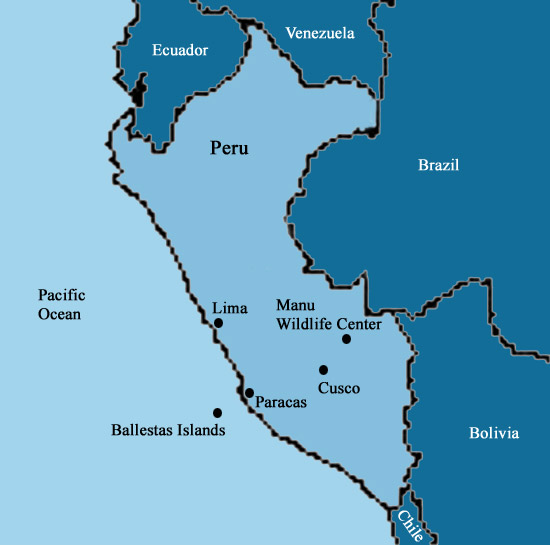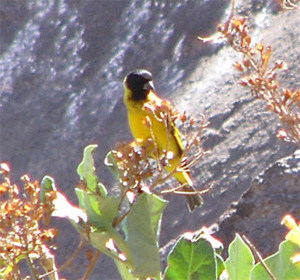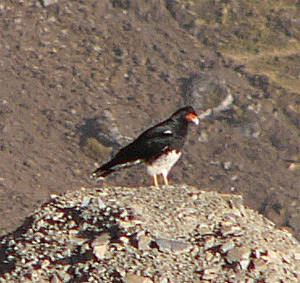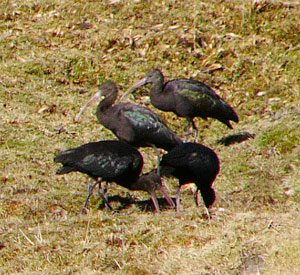
The Andes
This was another tour with Birdfinders. The trip began with an early-morning flight to Lima via Madrid followed by a night in a Lima hotel.
Next day we had another early-morning flight, this time to Cusco in the Andes where we were met by the people from Manu Expedititons including our guide for the trip, Dr Frank Lambert. Now it was time for the hour or so drive to Huacarpay Lakes for our first serious birding.

Hooded Siskin
On arrival at the first lake we immediately picked up two Plumbeous Rails (and a Common Moorhen!) in a marsh plus the first of many Rufous-collared Sparrows. Reedbeds held Yellow-winged Blackbirds and Wren-like Rushbirds. Truly a star of this habitat is the Many-colored Rush-tyrant and we saw at least five of these superb birds. A look at the sky overhead added White-collared Swifts and American Kestrels. First, we concentrated on a scrubby hillside quickly getting Rusty-fronted Canastero, our first of many endemics seen on this trip. We soon added a second endemic when we found our first hummingbird of the trip, a Bearded Mountaineer. Our second hummer soon followed and was somewhat larger: a Giant Hummingbird. The hillside also gave us Yellow-billed Tit-tyrant and our first of many tanagers: a superb male Blue-and-yellow Tanager. On the largest lake we added Andean Gull, Andean Coot and Andean Duck, so we were sure we knew where we were! plus a pair of White-tufted Grebes showed well. Walking along the lake edge, rock grassland bordering open water on one side and scrub-covered hillside on the other, new birds came thick and fast: two Andean Flickers and an Andean Lapwing fed on the grass as did a Rufous-naped Ground-tyrant. Green-tailed Trainbearer, White-browed Chat-tyrant, White-crested Elaenia, Ash-breasted Sierra-finch and Cinereous Conebill were found feeding in small trees and bushes. A Cattle Egret inserted a brief glimpse of more familiar European birding before South America again took over with three Hooded Siskins, Bare-eyed Ground-doves, Fulvous Wren, White-browed Ground-tyrant and Greenish Yellow-finch. A large tyrannid on a tall, thin, stick was soon identified as a hard-to-get Gray-bellied Shrike-tyrant.

Giant Hummingbird
We then drove round the lake to a small marshy pool for lunch. Whilst the drivers set up a table, chairs and all the food we scanned the water. Greater and Lesser Yellowlegs fed amongst Cinammon Teal, Andean Coot, Speckled Teal and Puna Teal. Yellow-billed Pintails sat and stood by the waterside and Spot-winged Pigeons flew overhead. A Puna Ibis put in an appearance as did a Black-billed Shrike-tyrant and a few Eared Doves. Chiguanco Thrushes were abundant.
En route to our hotel we stopped when a couple of raptors were spotted from the moving bus. A good time to stop as we all had the chance to admire three Black-chested Buzzard-eagles soaring overhead, plus Brown-chested Swallows and Andean Swifts feeding around a mountainside.
At the hotel we were soon birding around the lush gardens picking up more new birds: White-bellied Hummingbirds, Black-throated Flowerpiercer, a superb Black-backed Grosbeak, and a pair of Torrent Tyrranulets in addition to some birds we had seen earlier in the day.
For our third day we had quite a long drive up into the high mountains. We stopped on the way up and exited the bus to find it was pretty cold outside. Gloves and hats soon appeared. We had stopped at a site for White-tufted Sunbeam and we soon had seen at least three of these beautiful hummingbirds. A bird atop a tree turned out to be a Red-crested Cotinga and a singing bird lower down in the same tree was a Golden-billed Saltator. Quality birds but the best was to come. Frank played the call of Stripe-headed Antpitta and soon we were watching this great bird down to a couple of metres. Personally, I was very surprised at how large a bird it was. I had expected something much smaller. The first of quite a few Bar-winged Cincloides put in an appearance quickly superceded when Gill spotted three birds very high overhead. These turned out to be Andean Ibis and, although distant, were good birds to get. A short drive later we stopped again by a grassy mountainside and quickly found a couple of the endemic Junin Canastero singing on the low grass. Our final stop before our target location was necessitated by two Mountain Caracaras sitting by the side of the road.

Mountain Caracara
At the top of our mountain, although overshadowed by even higher mountains, we stopped for breakfast. We were at Abra Malaga at 4300m but everyone seemed OK. Bolstered by food and the sight of 33 Puna Ibis and four Andean Lapwings, plus more Mountain Caracaras and what was probably our three earlier-seen Andean Ibis flying past just below us calling loudly, we began the slow walk up the slope to get to the valley beyond. More Bar-winged Cincloides were seen soon followed by Tacanowski's and Cinereous Ground-tyrants, Plumbeous Sierra-finches and our main target species, Streak-fronted Canasetero. We made it to the top, an assent of only about 40 metres, and were rewarded with stupendous views of a huge valley and a huge snow-capped mountain. Truly a spectacular location to be in made even more special when Dave spotted two birds circling above the mountain in front of us. These were the hoped-for Andean Condors! An adult and a juvenile.

Puna Ibis
Time to begin the descent to the Polylepis woodland, a tree endemic of the Andean Paramos , location of some much-wanted endemic and rare species. We started with a surprisingly-confiding Puna Tapaculo, well, confiding for a tapaculo! At least it was in the open for a while. Plain-colored Seedeaters were found in our first scattered Polylepis trees but our target birds were in the denser woodland. The first bird to be found was a beautiful Tawny Tit-spinetail that came pretty close and showed very well. This was soon followed by Ash-breasted Tit-tyrant and two superb D'Orbigny's Chat-tyrants plus another Puna Tapaculo. However, these were overshadowed by our main target species found feeding quietly beneath the trees. It is very hard to see Royal Cincloides as they have very small, scattered populations and now very rare, with a population of probably only about 300 individuals in the world, but we managed it. Having seen this great bird we then added another endemic to the list in the form of White-browed Tit-tyrant. Birdfinders was certainly living up to its name and reputation. The rest of the walk down, after leaving the trees, was quiet but we did see Variable Hawk, the lovely Peruvian Sierra-finch and Blue-mantled Thornbill. After lunch we wandered only a couple of metres when we found another endemic: Chestnut-breasted Mountain-finch. Seeing this bird would save us time tomorrow as we had another site for it but it took some getting to. Some of us also picked up Tyrian Metaltail here, feeding on flowers only inches from the path.

